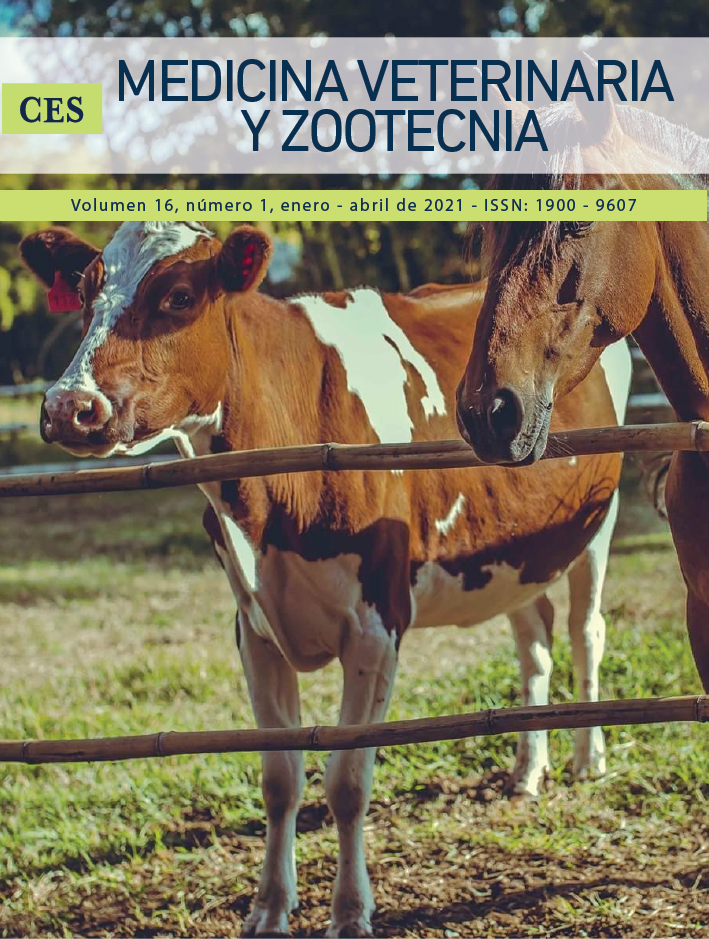Differences between SARS-CoV-2 and Avian Infectious Bronchitis (IBV) coronavirus
DOI:
https://doi.org/10.21615/cesmvz.16.1.3Keywords:
avian infectious bronchitis, coronavirus, SARS-CoV-2Abstract
The new coronavirus 2019 disease (COVID-19) is caused by the virus called SARS-CoV-2, however, in free-range chicken’s coronaviruses cause Avian Infectious Bronchitis. Currently, it has been possible to analyze the genomic sequence of the SARS-CoV-2 virus, which indicates that it emerged from an animal reservoir, it has even been considered that a virus isolated from a bat, identical to SARS-CoV, is the parent of the new coronavirus. In other studies, it has been shown that the glycoprotein of the viral spicule has a high degree of relationship between viruses that infect mammals and birds, which is the one that allows contact with the host. Whereas in the case of IBV, when inhaled, the virus will bind to sialic acid-containing glycoprotein receptors in hair epithelial cells of respiratory tissue, then viral replication will result in loss of ciliary function, mucus clearance, necrosis, and peeling, causing shortness of breath and suffocation. IBV affects the trachea, kidneys, and reproductive tract of many birds. In chickens, viremic IBV causes lesions in the magnum and the uterus. This review elucidates some key points in the differences between the novel coronavirus and the infectious bronchitis virus. SARS-CoV-2 is highly unlikely to infect or cause disease in poultry.
Downloads
References
Morse SS, Mazet JAK, Woolhouse M, et al. Prediction and prevention of the next pandemic zoonosis. Lancet. 2012;380(9857):1956–1965. doi: 10.1016/S0140-6736(12)61684-5
Schoeman D, Fielding BC. Coronavirus envelope protein: Current knowledge. Virol J. 2019;16(1). doi:10.1186/s12985-019-1182-0
Lee PI, Hsueh PR. Emerging threats from zoonotic coronaviruses-from SARS and MERS to 2019-nCoV. J Microbiol Immunol Infect. Published online 2020. doi:10.1016/j.jmii.2020.02.001
Fong IW, Fong IW. Emerging Animal Coronaviruses: First SARS and Now MERS. En: Emerging Zoonoses. Springer International Publishing; 2017:63–80. doi:10.1007/978-3-319-50890-0_4
Bande F, Arshad SS, Hair Bejo M, Moeini H, Omar AR. Progress and challenges toward the development of vaccines against avian infectious bronchitis. J Immunol Res. 2015;2015:424860. doi:10.1155/2015/424860
Lee C. Porcine epidemic diarrhea virus: An emerging and re-emerging epizootic swine virus. Virol J. 2015;12(1):193. doi:10.1186/s12985-015-0421-2
Whitworth J. COVID-19: a fast evolving pandemic. Trans R Soc Trop Med Hyg. 2020;114(4):241–248. doi:10.1093/trstmh/traa025
Andersen KG, Rambaut A, Lipkin WI, Holmes EC, Garry RF. The proximal origin of SARS-CoV-2. Nat Med. 2020;89(1):44–48. doi:10.1038/s41591-020-0820-9
Cavanagh D. Coronaviruses in poultry and other birds. Avian Pathol. 2005;34(6):439–448. doi:10.1080/03079450500367682
Gao Q, Hu Y, Dai Z, Xiao F, Wang J, Wu J. The Epidemiological Characteristics of 2019 Novel Coronavirus Diseases (COVID-19) in Jingmen, China. SSRN Electron J. Published online 24 de marzo de 2020:1–8. doi:10.2139/ssrn.3548755
Walsh KB, Lodoen MB, Edwards RA, Lanier LL, Lane TE. Evidence for Differential Roles for NKG2D Receptor Signaling in Innate Host Defense against Coronavirus-Induced Neurological and Liver Disease. J Virol. 2008;82(6):3021–3030. doi:10.1128/jvi.02032-07
Munster VJ, De Wit E, Feldmann H. Pneumonia from human coronavirus in a macaque model. N Engl J Med. 2013;368(16):1560–1562. doi:10.1056/NEJMc1215691
Chouljenko VN, Lin XQ, Storz J, Kousoulas KG, Gorbalenya AE. Comparison of genomic and predicted amino acid sequences of respiratory and enteric bovine coronaviruses isolated from the same animal with fatal shipping pneumonia. J Gen Virol. 2001;82(12):2927–2933. doi:10.1099/0022-1317-82-12-2927
Geng HY, Tan WJ. A novel human coronavirus: Middle East respiratory syndrome human coronavirus. Sci China Life Sci. 2013;56(8):683–687. doi:10.1007/s11427-013-4519-8
Peeri NC, Shrestha N, Rahman MS, et al. The SARS, MERS and novel coronavirus (COVID-19) epidemics, the newest and biggest global health threats: what lessons have we learned? Int J Epidemiol. Published online 22 de febrero de 2020. doi:10.1093/ije/dyaa033
Zhou P, Yang X Lou, Wang XG, et al. A pneumonia outbreak associated with a new coronavirus of probable bat origin. Nature. 2020;579(7798):270–273. doi:10.1038/s41586-020-2012-7
Shulla A, Heald-Sargent T, Subramanya G, Zhao J, Perlman S, Gallagher T. A Transmembrane Serine Protease Is Linked to the Severe Acute Respiratory Syndrome Coronavirus Receptor and Activates Virus Entry. J Virol. 2011;85(2):873–882. doi:10.1128/jvi.02062-10
Cao Y, Li L, Feng Z, et al. Comparative genetic analysis of the novel coronavirus (2019-nCoV/SARS-CoV-2) receptor ACE2 in different populations. Cell Discov. 2020;6(1):1–4. doi:10.1038/s41421-020-0147-1
Wang H, Yuan X, Sun Y, et al. Infectious bronchitis virus entry mainly depends on clathrin mediated endocytosis and requires classical endosomal/lysosomal system. Virology. 2019;528:118–136. doi:10.1016/j.virol.2018.12.012
Nextstrain: real-time tracking of pathogen evolution | Bioinformatics | Oxford Academic.
Cavanagh D. Coronavirus avian infectious bronchitis virus. Vet Res. 2007;38(2): 281–297. doi:10.1051/vetres:2006055
Guy JS. Turkey coronavirus is more closely related to avian infectious bronchitis virus than to mammalian coronaviruses: A review. Avian Pathol. 2000;29(3):207–212. doi:10.1080/03079450050045459
Cavanagh D, Mawditt K, Welchman DDB, Britton P, Gough RE. Coronaviruses from pheasants (Phasianus colchicus) are genetically closely related to coronaviruses of domestic fowl (infectious bronchitis virus) and turkeys. Avian Pathol. 2002;31(1):81–93. doi:10.1080/03079450120106651
Zhang T, Wu Q, Zhang Z. Probable Pangolin Origin of SARS-CoV-2 Associated with the COVID-19 Outbreak. Curr Biol. 2020;30(7):1346-1351.e2. doi:10.1016/j.cub.2020.03.022
Jackwood MW. The Relationship of Severe Acute Respiratory Syndrome Coronavirus with Avian and Other Coronaviruses. Avian Dis. 2006;50(3):315–320. doi:10.1637/7612-042006r.1
Rothan HA, Byrareddy SN. The epidemiology and pathogenesis of coronavirus disease (COVID-19) outbreak. J Autoimmun. 2020;109:102433. doi:10.1016/j.jaut.2020.102433
Gibbs AJ, Gibbs MJ, Armstrong JS. The phylogeny of SARS coronavirus. Arch Virol. 2004;149(3):621–624. doi:10.1007/s00705-003-0244-0
Li W, Shi Z, Yu M, et al. Bats are natural reservoirs of SARS-like coronaviruses. Science (80- ). 2005;310(5748):676–679. doi:10.1126/science.1118391
Wang LF, Walker PJ, Poon LLM. Mass extinctions, biodiversity and mitochondrial function: Are bats “special” as reservoirs for emerging viruses? Curr Opin Virol. 2011;1(6):649–657. doi:10.1016/j.coviro.2011.10.013
Woo PCY, Huang Y, Lau SKP, Yuen KY. Coronavirus genomics and bioinformatics analysis. Viruses. 2010;2(8):1805–1820. doi:10.3390/v2081803
Cavanagh D, Davis PJ, Mockett APA. Amino acids within hypervariable region 1 of avian coronavirus IBV (Massachusetts serotype) spike glycoprotein are associated with neutralization epitopes. Virus Res. 1988;11(2):141–150. doi:10.1016/0168-1702(88)90039-1
Kant A, Koch G, Van Roozelaar DJ, Kusters JG, Poelwijk FAJ, Van der Zeijst BAM. Location of antigenic sites defined by neutralizing monoclonal antibodies on the S1 avian infectious bronchitis virus glycopolypeptide. J Gen Virol. 1992;73(3):591– 596. doi:10.1099/0022-1317-73-3-591
Li W, Junker D, Hock L, Ebiary E, Collisson EW. Evolutionary implications of genetic variations in the S1 gene of infectious bronchitis virus. Virus Res. 1994;34(3): 327–338. doi:10.1016/0168-1702(94)90132-5
Lee CW, Hilt DA, Jackwood MW. Typing of field isolates of infectious bronchitis virus based on the sequence of the hypervariable region in the S1 gene. J Vet Diagnostic Investig. 2003;15(4):344–348. doi:10.1177/104063870301500407
Saif LJ. Coronaviruses of Domestic Livestock and Poultry: Interspecies Transmission, Pathogenesis, and Immunity. En: Nidoviruses. American Society of Microbiology; 2014:279–298. doi:10.1128/9781555815790.ch18
Chen Y, Liu Q, Guo D. Emerging coronaviruses: Genome structure, replication, and pathogenesis. J Med Virol. 2020;92(4):418–423. doi:10.1002/jmv.25681
Fehr AR, Perlman S. Coronaviruses: An overview of their replication and pathogenesis. En: Coronaviruses: Methods and Protocols. Springer New York; 2015:1–23. doi:10.1007/978-1-4939-2438-7_1
Su S, Wong G, Shi W, et al. Epidemiology, Genetic Recombination, and Pathogenesis of Coronaviruses. Trends Microbiol. 2016;24(6):490–502. doi:10.1016/j.tim.2016.03.003
Simas PVM, DE Souza Barnabé AC, Durães-Carvalho R, et al. Bat coronavirus in Brazil related to appalachian ridge and porcine epidemic diarrhea viruses. Emerg Infect Dis. 2015;21(4):729–731. doi:10.3201/eid2104.141783
Cui J, Li F, Shi ZL. Origin and evolution of pathogenic coronaviruses. Nat Rev Microbiol. 2019;17(3):181–192. doi:10.1038/s41579-018-0118-9
Promkuntod N, van Eijndhoven REW, de Vrieze G, Gröne A, Verheije MH. Mapping of the receptor-binding domain and amino acids critical for attachment in the spike protein of avian coronavirus infectious bronchitis virus. Virology. 2014;448:26–32. doi:10.1016/j.virol.2013.09.018
Babcock GJ, Esshaki DJ, Thomas WD, Ambrosino DM. Amino Acids 270 to 510 of the Severe Acute Respiratory Syndrome Coronavirus Spike Protein Are Required for Interaction with Receptor. J Virol. 2004;78(9):4552–4560. doi:10.1128/jvi.78.9.4552-4560.2004
Casais R, Dove B, Cavanagh D, Britton P. Recombinant Avian Infectious Bronchitis Virus Expressing a Heterologous Spike Gene Demonstrates that the Spike Protein Is a Determinant of Cell Tropism. J Virol. 2003;77(16):9084–9089. doi:10.1128/jvi.77.16.9084-9089.2003
Ignjatovic J, Ashton DF, Reece R, Scott P, Hooper P. Pathogenicity of Australian strains of avian infectious bronchitis virus. J Comp Pathol. 2002;126(2–3):115–123. doi:10.1053/jcpa.2001.0528
Shahwan K, Hesse M, Mork AK, Herrler G, Winter C. Sialic acid binding properties of soluble coronavirus spike (S1) proteins: Differences between infectious bronchitis virus and transmissible gastroenteritis virus. Viruses. 2013;5(8):1924–1933. doi:10.3390/v5081924
Winter C, Schwegmann-Weßels C, Cavanagh D, Neumann U, Herrler G. Sialic acid is a receptor determinant for infection of cells by avian Infectious bronchitis virus. J Gen Virol. 2006;87(5):1209–1216. doi:10.1099/vir.0.81651-0
Chu VC, McElroy LJ, Chu V, Bauman BE, Whittaker GR. The Avian Coronavirus Infectious Bronchitis Virus Undergoes Direct Low-pH-Dependent Fusion Activation during Entry into Host Cells. J Virol. 2006;80(7):3180–3188. doi:10.1128/jvi.80.7.3180-3188.2006
Crinion RA, Hofstad MS. Pathogenicity of four serotypes of avian infectious bronchitis virus for the oviduct of young chickens of various ages. Avian Dis. 1972;16(2):351–363. Accedido abril 10, 2020. http://www.ncbi.nlm.nih.gov/pubmed/4552675
Patel BH, Bhimani MP, Bhanderi BB, Jhala MK. Isolation and molecular characterization of nephropathic infectious bronchitis virus isolates of Gujarat state, India. VirusDisease. 2015;26(1–2):42–47. doi:10.1007/s13337-015-0248-x
Zhu N, Zhang D, Wang W, et al. A novel coronavirus from patients with pneumonia in China, 2019. N Engl J Med. 2020;382(8):727–733. doi:10.1056/NEJMoa2001017
University of Medicine Johns Hopkins. Coronavirus COVID-19 Global Cases by the Center for Systems Science and Engineering (CSSE) at Johns Hopkins. University of Medicine Johns Hopkins.
Munster VJ, Koopmans M, van Doremalen N, van Riel D, de Wit E. A Novel Coronavirus Emerging in China — Key Questions for Impact Assessment. N Engl J Med. 2020;382(8):692–694. doi:10.1056/nejmp2000929
Li Q, Guan X, Wu P, et al. Early Transmission Dynamics in Wuhan, China, of Novel Coronavirus–Infected Pneumonia. N Engl J Med. 2020;382(13):1199–1207. doi:10.1056/nejmoa2001316
Lessler J, Reich NG, Brookmeyer R, Perl TM, Nelson KE, Cummings DA. Incubation periods of acute respiratory viral infections: a systematic review. Lancet Infect Dis. 2009;9(5):291–300. doi:10.1016/S1473-3099(09)70069-6
Park JE, Jung S, Kim A, Park JE. MERS transmission and risk factors: A systematic review. BMC Public Health. 2018;18(574). doi:10.1186/s12889-018-5484-8
Liu S, Chen J, Chen J, et al. Isolation of avian infectious bronchitis coronavirus from domestic peafowl (Pavo cristatus) and teal (Anas). J Gen Virol. 2005;86(3):719–725. doi:10.1099/vir.0.80546-0
Abdel-Moneim AS. Coronaviridae: Infectious Bronchitis Virus. En: Emerging and Re-emerging Infectious Diseases of Livestock. ; 2016:133–166. doi:10.1007/978-3-319-47426-7
Sun J, He WT, Wang L, et al. COVID-19: Epidemiology, Evolution, and Cross-Disciplinary Perspectives. Trends Mol Med. 2020;26(5):483–495. doi:10.1016/j.molmed.2020.02.008
Lau SKP, Li KSM, Huang Y, et al. Ecoepidemiology and Complete Genome Comparison of Different Strains of Severe Acute Respiratory Syndrome-Related Rhinolophus Bat Coronavirus in China Reveal Bats as a Reservoir for Acute, Self-Limiting Infection That Allows Recombination Events. J Virol. 2010;84(6):2808–2819. doi:10.1128/jvi.02219-09
Kim Y, Kim S, Kim S-M, et al. Infection and Rapid Transmission of SARS-CoV-2 in Ferrets. Cell Host Microbe. 2020;27. doi:10.1016/j.chom.2020.03.023
Chan JFW, Yuan S, Kok KH, et al. A familial cluster of pneumonia associated with the 2019 novel coronavirus indicating person-to-person transmission: a study of a family cluster. Lancet. 2020;395(10223):514–523. doi:10.1016/S0140-6736(20)30154-9
Gorbalenya AE, Baker SC, Baric RS, et al. The species Severe acute respiratory syndrome-related coronavirus: classifying 2019-nCoV and naming it SARSCoV-2. Nat Microbiol. 2020;5(4):536–544. doi:10.1038/s41564-020-0695-z
Wang Q, Zhang Y, Wu L, et al. Structural and Functional Basis of SARS-CoV-2 Entry by Using Human ACE2. Cell. Published online 2020. doi:10.1016/j.cell.2020.03.045
Ramakrishnan S, Kappala D. Avian infectious bronchitis virus. Recent Adv Anim Virol. Published online 2019:301–309. doi:10.20506/rst.19.2.1228
Iglesias-Osores S, Saavedra-Camacho J. Will SARS-CoV-2 cause diseases in poultry? Sci Agropecu. 2020;11(2):281. doi:10.17268/sci.agropecu.2020.02.17
Zhao Z, Li H, Wu X, et al. Moderate mutation rate in the SARS coronavirus genome and its implications. BMC Evol Biol. 2004;4(1):1–9. doi:10.1186/1471-2148-4-21
Bush RM. Influenza as a model system for studying the cross-species transfer and evolution of the SARS coronavirus. En: May RM, McLean AR, Pattison J, Weiss RA, eds. Philosophical Transactions of the Royal Society B: Biological Sciences. Vol 359. Royal Society; 2004:1067–1073. doi:10.1098/rstb.2004.1481
Downloads
Published
How to Cite
Issue
Section
License
Copyright (c) 2021 CES Medicina Veterinaria y Zootecnia

This work is licensed under a Creative Commons Attribution-ShareAlike 4.0 International License.
| Article metrics | |
|---|---|
| Abstract views | |
| Galley vies | |
| PDF Views | |
| HTML views | |
| Other views | |



